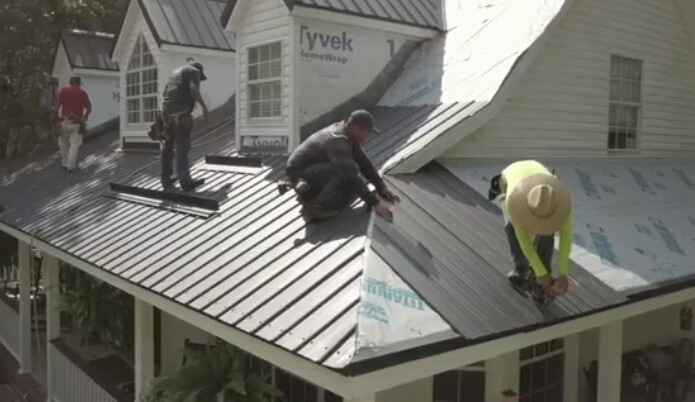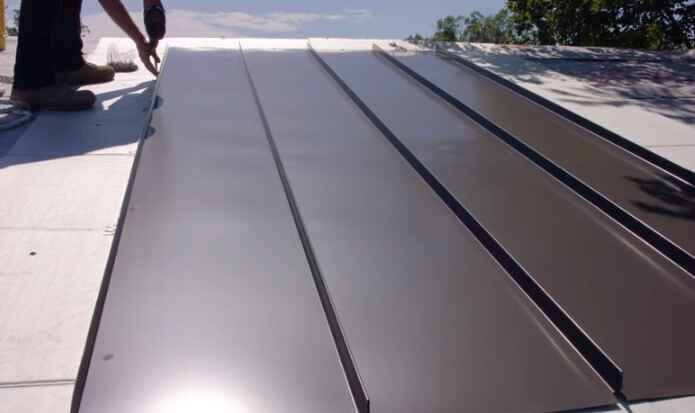Yes, it is possible to install a metal roof over shingles. However, proper preparation and installation techniques, including the use of a batten system or metal roofing panels designed for this purpose, are crucial for a successful and durable installation.
Embarking on a roofing adventure? Wondering if you can upgrade to a sleek metal roof without the hassle of tearing off your old shingles? Well, fellow DIY enthusiasts, you're in for a treat! In this blog post, we're diving headfirst into the exciting realm of putting a metal roof over shingles. Discover the ins and outs, unleash your inner DIY guru, and get ready to elevate your home's style with this ingenious roofing solution. Let's turn those shingles into a metallic masterpiece together!

Metal roofing is an increasingly popular choice for homeowners due to its superior durability and resistance against adverse weather conditions. Here are five reasons why metal roofing can be a great investment:
1. Durability:
Metal roofs are designed to last between 40-70 years, far longer than traditional asphalt shingle roofs which typically last 15-30 years. Not only do they last longer, but metal roofs also have the ability to withstand severe storms, high winds, snow, and even hail damage with minimal damage or deterioration.
2. Cost Effectiveness:
Although metal roofing systems may initially cost more than traditional shingle roofs, you can save significant money in the long run due to their extremely long lifespan. The low maintenance costs and energy savings of metal roofing systems can also add up, making them a cost-effective option over time.
3. Energy Efficiency:
Metal roofs are extremely reflective and help to deflect the sun's heat, which can help keep your home cooler in the summer. This will reduce your energy expenses as less energy is needed to cool your home. Additionally, many metal roofs have added insulation layers that can improve energy efficiency and help reduce utility costs.
4. Lightweight:
Metal roofs are much lighter than traditional asphalt shingle roofs, making them easier to install and maintain. This helps to save on construction costs since it requires fewer people or equipment to install a metal roof versus an asphalt shingle roof.
5. Aesthetics:
Metal roofs come in various styles and colors that can help add character to your home while providing superior protection against the elements. Additionally, they are designed to be low maintenance and require little upkeep over time. This makes metal roofing a great choice if you're looking for a more aesthetically pleasing and durable roof.

Cons of installing metal roofing over shingles
Metal roofing is popular for many homeowners due to its long lifespan and durability. However, there are some drawbacks to consider when installing metal roofing over shingles.
1: Cost
Installing metal roofing over an existing shingle roof can be expensive. Since the old shingle roof must be removed first, this could add thousands of labor costs. In addition, metal roofs require specialized tools and installation techniques that most contractors may not have experience using.
2: Weight
Metal roofs are heavier than traditional asphalt roofs, adding extra stress to the structure below. Before deciding to install one over an existing shingle roof, it's important to ensure that the existing frame and joists are strong enough to bear the additional weight.
3: Noise
Metal roofs transfer sound more easily than asphalt shingle roofing, making it noisier when rain or wind hits. Installing insulation between the metal roof and the existing shingle roof can help reduce noise levels, but this could add more cost to the project. Additionally, unless you choose a heavy gauge metal, hail storms may be louder on a metal roof versus an asphalt one.
Factors to consider before installing metal roofing over shingles
Installing metal roofing over shingles is a great way to increase your home or building's longevity and weather resistance. Here are six factors to consider before installing metal roofing:
Consider the Pitch of Your Roof
The pitch of your roof should be considered before installing a metal roof. Ideally, the slope should be at least 3 inches every 12 feet; otherwise, water can pool on the surface and cause damage over time. Additionally, some roofs may require additional layers of underlayment for extra protection.
Check Load Bearing Capacity of Your Home
Metal roofing is usually heavier than traditional shingle roofs, so it's important to check the load-bearing capacity of your home before beginning installation. If your structure cannot handle the weight of a metal roof, you will need to reinforce the support beams or choose another material.
Prep the Roof Surface for Installation
Before installing a metal roof, remove existing shingles and remove dirt and debris from the surface. Additionally, check for any damage caused by pests or weather and repair as needed before installing.
Ensure Adequate Ventilation in Your Attic Space
Proper ventilation is essential for metal roof installation to ensure moisture doesn't get trapped between the roofing and the underlying structure. Ensure ample intake and exhaust vents are in your attic space before installing a metal roof.
Consider Your Region's Climate Conditions
Selecting the right type of metal roof that can withstand extreme temperatures, high winds, and other harsh weather conditions in your region is important. Choose materials specifically designed for your local climate to get the most out of your investment.
Follow All Safety Guidelines During the Installation
Finally, following all safety guidelines during installation, including wearing appropriate protective gear when working with metal roofing materials, is important. Follow the manufacturer's instructions for proper installation, and never use power tools on wet surfaces.
How to Install metal roof over shingles: Step-by-step guide
Installing metal roofing over shingles is a great way to improve your home's longevity and weather resistance. Here are seven steps for completing this project successfully:
1. Preparing the Surface:
Start by removing all debris from the existing roof and making sure that the surface is flat and even. Apply an insulation board and a vapor barrier sheet to provide additional protection against moisture buildup.
2. Installing Starter Strips:
Measure and cut starter strips to fit along each edge of the roof perimeter and use fasteners to secure them in place. This helps ensure your new metal panels will lay down evenly across the entire surface area.
3. Placing Underlayment Sheet:
Add a layer of underlayment sheet, which acts as an additional protective barrier and helps to reduce noise from rain and hail. Make sure the underlayment is secured with staples or other fasteners.
4. Laying Down Metal Panels:
Begin laying down metal panels at the roof's lowest edge and work up, overlapping each panel slightly. Install any necessary clips or brackets to secure them in place.
5. Sealing the Edges:
Use a sealant along all edges where metal meets another material, such as brick or siding, ensuring that no moisture can penetrate through these areas into your home.
6. Installing Flashing:
Place flashing along any areas where two pieces of metal intersect and around vents and other protrusions. This helps to direct water away from these points and reduce the risk of leaks.
7. Applying a Final Coating:
Finish by applying a coat of paint or sealant to your new metal roof to protect it from further weather damage. Ensure all sides are evenly coated for maximum protection against the elements.
Following these steps will ensure that your new metal roof is properly installed and lasts many years! Good luck with your project!

Maintenance and care of metal roofing
Metal roofing can provide a great way to protect your home from the elements. Proper maintenance and care of metal roofs are essential to ensure their longevity and effectiveness. Here are six tips to keep your metal roof in top condition:
1. Clean Regularly:
To ensure that dirt, debris, and moss do not accumulate on the surface of the metal roof, regularly clean it with warm water and a mild detergent or solution designed for use on metals.
2. Inspect for Damage:
Periodically inspect the roof for any signs of wear, such as loose screws, rust, dents, or holes that may need repair. Make sure to report any damage you find right away so it can be addressed promptly before it worsens.
3. Keep Gutters Clean:
Clear away debris from gutters and drains to ensure proper rainwater drainage from the roof. This will help prevent water damage and wear on the metal panels.
4. Check for Leaks:
Have an expert inspect your roof for any potential leaks or damage that could lead to leaking water, which can cause significant damage over time if left unchecked.
5. Paint as Needed:
Repaint the metal roof every few years to keep it in good condition and protect it from corrosion and other damages caused by weather exposure.
6. Trim Trees:
Make sure to trim any trees near your home, so they do not hang over the roof and cause damage to the metal surface. This will reduce the risk of scratches, dents, and other forms of wear that could damage the metal panels.
Following these tips will help you keep your metal roof in great condition for years to come!
Conclusion
In conclusion, putting a metal roof over shingles is a viable option for homeowners who want to upgrade their roofing system without removing the existing shingles. While it may seem like an easy and cost-effective solution, it's important to remember that this process requires proper installation techniques and attention to detail to avoid potential problems in the future. Before installing a metal roof over shingles, it's best to consult with a professional roofing contractor to ensure that your roof can support the additional weight and assess any potential issues with the existing shingles. Ultimately, with the right preparation and installation, a metal roof can provide a durable and long-lasting solution for your home's roofing needs.